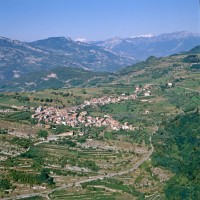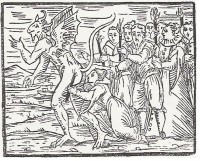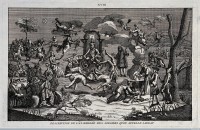 A woman who was convicted of witchcraft and executed in 1716 may get a new trial 299 after her death. The city council of Brentonico, the town in the Italian Alps where Maria Bertoletti Toldini was put to death for her ostensible crimes, has petitioned the court to reopen the case. Brentonico Mayor Christian Perenzoni believes Maria’s fate was the result of “folkloric excess around the trials and killings of so-called witches” and wants “to render justice and historical truth, and give back the condemned woman her ethical, moral and civil dignity.”
A woman who was convicted of witchcraft and executed in 1716 may get a new trial 299 after her death. The city council of Brentonico, the town in the Italian Alps where Maria Bertoletti Toldini was put to death for her ostensible crimes, has petitioned the court to reopen the case. Brentonico Mayor Christian Perenzoni believes Maria’s fate was the result of “folkloric excess around the trials and killings of so-called witches” and wants “to render justice and historical truth, and give back the condemned woman her ethical, moral and civil dignity.”
Maria Bertoletti Toldini, known as Toldina, was born and raised in Pilcante, a village eight miles southeast of Brentonico. She was widowed and remarried Andrea Toldini, sacristan of the church of San Martino in the neighboring town of Ala. Toldina had no children with either of her husbands. She was 60 years old when she was arrested for witchcraft, acts of evil, sorcery, sacrilege, idolatry, apostasy, sodomy, fornication, consorting with the devil and infanticide. The child murder allegations in particular inflamed the population against her and sealed her fate.
According to the prosecution, as recorded in an 18th century transcript of the sentencing, Toldina’s life of depraved ignominy began when she was 13 years old and was seduced to evil by her witch aunt Agostina Bertoletti. In the middle of a Monday night, Agostina took her niece to a meeting of demons presided over by the devil with goat’s hooves as hands and feet. Maria, on her knees before the devil, renounced God, the Trinity, the Holy Virgin and all the saints. She repudiated the Christian faith, the Catholic religion, the sacrament of Baptism and her first name of Maria which was odious to Satan. The demon gave her a new name, rebaptised her by pouring a foul black liquid down her back and marked her with a cold iron instrument on her left arm.
 The 13-year-old then purportedly swore fealty to the demon and declared herself his vassal. She agreed to bewitch one child a month and perform every kind of evil on them, to spread grave illness among people. In return the devil would make miracles for her, satisfy her uncontrollable lusts and bless her after her death. From then on, Toldina attended witches’ sabbaths every night, using an ointment made of sacramental ashes, holy water, oil and wax from candles lit during Holy Week (all materials easily secured because of her sacristan husband) to fly to local meetups and far-flung ones. There she danced, stepping always to the left, and repeatedly kissed the devil’s ass. Toldina gave her virginity to the demon who appeared in the form of a young man and had sex with her, his touch freezing cold.
The 13-year-old then purportedly swore fealty to the demon and declared herself his vassal. She agreed to bewitch one child a month and perform every kind of evil on them, to spread grave illness among people. In return the devil would make miracles for her, satisfy her uncontrollable lusts and bless her after her death. From then on, Toldina attended witches’ sabbaths every night, using an ointment made of sacramental ashes, holy water, oil and wax from candles lit during Holy Week (all materials easily secured because of her sacristan husband) to fly to local meetups and far-flung ones. There she danced, stepping always to the left, and repeatedly kissed the devil’s ass. Toldina gave her virginity to the demon who appeared in the form of a young man and had sex with her, his touch freezing cold.
Using the ointment, Toldina killed a girl, Margarita, daughter of Saiano of Saiano of Pilcante, she had already afflicted with dropsy. In 1714 she smeared the unguent on a baby from the same family, Felice Saiano, who developed tumors and died. The year before she mixed ashes in butter and killed Lorenzo, son of Giovanni Ecchelli of the Iseppi of Pilcante, also with cancerous tumors. In 1711, she broke into the home of Giacomo Antonio Venturi of Pilcante and threw his five-year-old son Pietro in a bronze cauldron full of boiling cheese. Her unguent claimed another young victim — three-year-old Antonio, son of Carlo Balconi — after she spread it on his stomach. The same fate awaited Toldina’s own nephew, Adrea, son of her brother Giovanni Bertoletti, who was two years old, and Bartolomea, four-year-old daughter of Giovanni Maria of Vallarsa. Toldina killed the child of Maddalena, wife of Francesco Balconi, in the womb.
 Her dark arts cut a swath through the adults of Pilcante and environs as well, most of them women. They weren’t killed, but struck with severe illnesses and their husbands were cursed with sterility. We can rest assured all of these things happened because witnesses testified to them and Toldina herself, under torture, confessed to these acts and more.
Her dark arts cut a swath through the adults of Pilcante and environs as well, most of them women. They weren’t killed, but struck with severe illnesses and their husbands were cursed with sterility. We can rest assured all of these things happened because witnesses testified to them and Toldina herself, under torture, confessed to these acts and more.
The trial took place at the Castle of Avio, the last witch trial ever held at the castle. After she was sentenced to death, on March 14th, 1716, Toldina was taken to Palù Park in Brentonico where a gallows stood. A headsman was paid 75 German florins to decapitate her before the assembled townspeople. Her body and head were then burned.
Toldina was tried by lay authorities, not the church, because Bretonica, part of the Prince-Bishopric of Trent since the Middle Ages, was reclaimed as a direct dominion of the Habsurg Holy Roman Emperors in the early 1700s. In fact, the town had just received its Captain of Justice — a role combining chief of police and criminal judge — a few weeks before Toldina’s trial. Unfortunately the municiple archives were destroyed during World War II so the only original records of the trial to survive were the sentence and the defense summary by Toldina’s lawyer, notary Giovanni Battista del Pozzo.
The legal challenges to reopening this case are significant, to put it mildly. Bretonico is in the nothern Italian autonomous region of Trentino so the court of appeals of regional capitol Trento will hear the case. They will have to establish the facts with only two original documents from her trial extant. Not only that, but the court will have to use the law applied to the original trial, the Constitutio Criminalis Carolina. That means the new advocates will have to be knowledgeable in 16th century German jurisprudence, a tall order if I’ve heard one. Historian Carlo Andrea Postinger, already commissioned by the city council to search for original documents, will be on hand to consult should the appeal be granted.